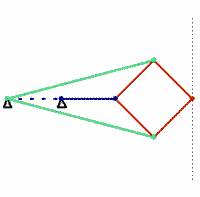
las barras del mismo color tienen la misma longitud.
El mecanismo de Peaucellier-Lipkin es un conjunto de barras articuladas que transforma un movimiento circular en un movimiento rectilíneo. Las barras se mueven en planos paralelos muy cercanos y se considera que se mueven en un solo plano.
Fue inventado en 1864 por el francés Charles-Nicolas Peaucellier (1832-1913) y el lituano Yom Tov Lipman Lipkin. El primero era un oficial del ejército y el segundo el hijo del rabbí Israel Salanter.[1][2]
Este mecanismo fue muy útil en el desarrollo de la máquina de vapor.
Un mecanismo similar, el mecanismo de Sarrus, fue anterior pero no se aplicó a ninguna máquina.
YouTube Encyclopedic
-
1/3Views:69421 9263 575
-
Mecanismo articulado de Peaucellier que traza exactamente una línea recta
-
Kinematics with MicroStation - Ch02E Exact Straight Line Mechanisms
-
Paucellier's Lipkin Mechanism
Transcription
Geometría
Según la figura adjunta hay seis barras rígidas (de longitud constante): OA, OC, AB, BC, CD, DA.
Las longitudes son: OA = OC, AB = BC = CD = DA. Si el punto O es fijo y el punto B se mueve siguiendo un círculo (indicado en rojo en la figura) que pasa por O, entonces el punto D se moverá según una línea recta (indicada en azul).
